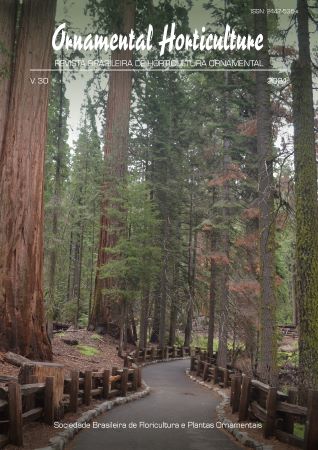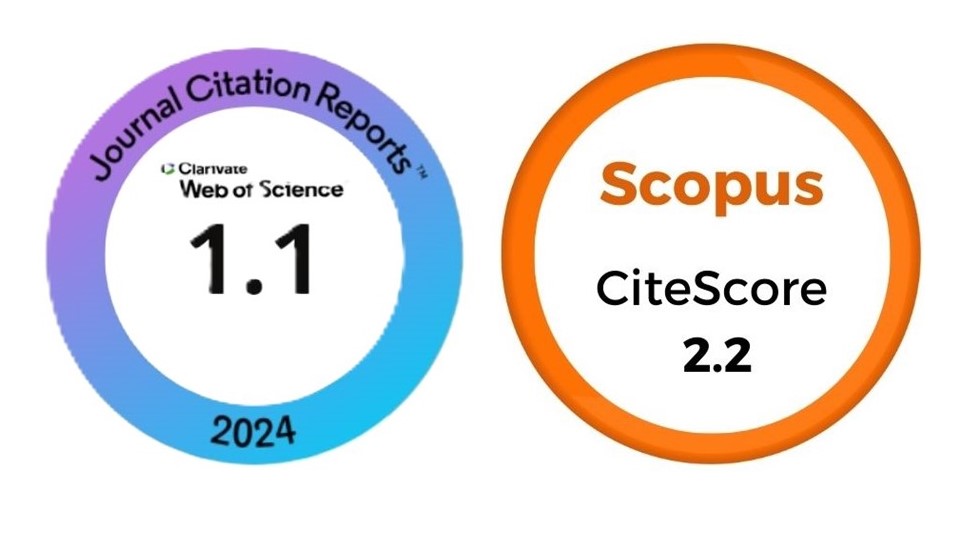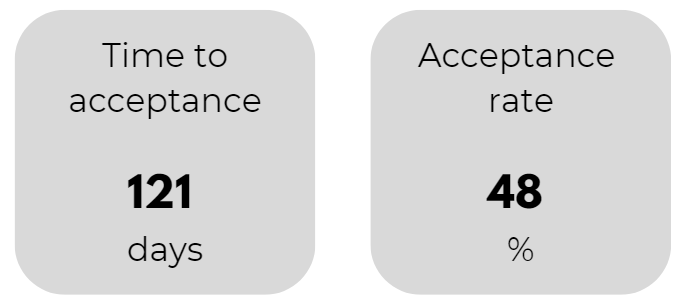Análise etnobotânica do conhecimento dos produtores de plantas ornamentais no Benin: perspectivas de valorização e manejo
DOI:
https://doi.org/10.1590/2447-536X.v30.e242736Palavras-chave:
África Ocidental, Benin, conhecimento tradicional, etnobiologia, plantas decorativas, práticas horticulturais, significado culturalResumo
Este estudo teve como objetivo analisar o conhecimento etnobotânico dos produtores de plantas ornamentais em Benin para uma melhor valorização. Um levantamento etnobotânico foi conduzido por meio de entrevistas semiestruturadas e individuais com 80 indivíduos. No total, foram identificadas 78 espécies de plantas ornamentais pertencentes a 25 famílias botânicas. As famílias Euphorbiaceae (15,38%), Apocynaceae (12,82%), Araceae (11,54%) e Verbenaceae (6,41%) foram as mais dominantes. Cinco categorias de usos foram identificadas para plantas ornamentais em Benin, incluindo uso estético ou decorativo, psico-mágico, terapêutico, cosmético e alimentar. Entre esses, o uso estético ou decorativo de plantas ornamentais foi amplamente reconhecido pelos produtores (100% dos produtores pesquisados), seguido pelo uso para fins psico-mágicos (45,7% dos entrevistados). A frequência de citação de diferentes categorias de uso variou de acordo com o gênero, idade, grupo étnico e nível educacional dos produtores entrevistados. O grupo étnico e o nível educacional influenciaram significativamente o conhecimento etnobotânico dos produtores de plantas ornamentais. As primeiras espécies mostrando um forte potencial para uso etnobotânico foram Citrus aurantiifolia (UVI = 10,78), Lippia multiflora (UVI = 9,70), Ocimum basilicum (UVI = 9,03), Verbena bonariensis (UVI = 8,14), Dracaena braunii (UVI = 8,08). Esses resultados podem ser considerados como uma fonte importante de informação para o manejo do setor de plantas ornamentais em Benin.
Downloads
Referências
ALTMAN, A.; SHENNAN, S.; ODLING-SMEE, J. Ornamental plant domestication by aesthetics-driven human cultural niche construction. Trends in Plant Science, v.27, n.2, p.124-138, 2022. https://doi.org/10.1016/j.tplants.2021.09.004
ARSHAD, F.; WAHEED, M.; IQBAL, M.; FATIMA, K.; FATIMA, K. Ethnobotanical assessment of woody flora of district Kasur (Punjab), Pakistan. Ethnobotany Research and Applications, v.20, p.1-13, 2020. https://doi.org/10.32859/era.20.33.1-13
AZONBAKIN, S.; DANGBEMEY, P.; OSSENI, R., YAUDE, S.A.; KORA, F.; ADOVOEKPE, D.; AWEDE, B. Enquête ethnobotanique sur les plantes utilisées dans le traitement de l’infertilité masculine au Benin. International Journal of Biological and Chemical Sciences, v.15, n.4, p.1667-1677, 2021. https://doi.org/10.4314/ijbcs.v15i4.28
BARCO, A.; BORIN, M. Ornamental plants for floating treatment wetlands: Preliminary results. Italian Journal of Agronomy, v.15, n.2, p.109-120, 2020. https://doi.org/10.4081/ija.2020.1602
DAGNELIE, P. Statistique théorique et appliquée : Tome 1, Inférence statistique à une et à deux dimensions. Paris, Bruxelles: De Boek & Larcier, 1998.
DONOU HOUNSODE, M.T.; ASSOGBADJO, A.E.; HOUEHANOU, T.; GLELE KAKAÏ, R.L.; AGBANGLA, C. Facteurs socioéconomiques influençant l’usage des Raphias au Bénin (Afrique de l’Ouest). Science de la Vie, de la Terre et AgronomieREV. CAMES, v.4, p.2424-7235, 2016.
DOSSOU, M.E.; HOUESSOU, G.L.; LOUGBEGNON, O.T.; RENTE, A.H.B. ; CODJIA, J.T.C. Etude ethnobotanique des ressources forestières ligneuses de la forêt marécageuse d’Agonvè et terroirs connexes au Bénin. Tropicultura, v.30, n.1, p. 41-48, 2012.
FAUTRAS, M.; VEITH, B. Marchandisation et patrimonialisation du végétal: les critères esthétiques de la création variétale de roses coupées. Belgeo, 2, 2022. https://doi.org/10.4000/belgeo.54852
FRANCINI, A.; ROMANO, D.; TOSCANO, S. The contribution of ornamental plants to urban ecosystem services. Earth, v.3, n.4, p.1258-1274, 2022. https://doi.org/10.3390/earth3040071
GANLAKI, T.H.; MEDEHOUENOU, T.C.M.; KOUGNIMON, F.E.E.; MENSAH, D.D.J.; DOUGNON, T.V.; YEDOMONHAN, H.; AKPOVI, D.C. Étude ethnobotanique des plantes médicinales utilisées dans la contraception masculine au Sud-Bénin. Journal of Applied Biosciences, v.169, n.1, p.17645-17657, 2022. https://doi.org/10.35759/JABs.169.9
GARCÍA-ÁVILA, F.; AVILÉS-AÑAZCO, A.; CABELLO-TORRES, R. Application of ornamental plants in constructed wetlands for wastewater treatment: A scientometric analysis. Case Studies in Chemical and Environmental Engineering, v.7, p.100307, 2023. https://doi.org/10.1016/j.cscee.2023.100307
HERNÁNDEZ-RODRÍGUEZ, E.; LÓPEZ-SANTIAGO, J. Uses and traditional knowledge of Dendropogonella rufescens (Bryophyta: Cryphaeaceae) in a Zapotec community of southeastern Mexico. Botanical Sciences, v.100, n.1, p.153-168, 2022. https://doi.org/10.1556/022.2020.00021
HIERNAUX, Q. The ethics of plant flourishing and agricultural ethics: theoretical distinctions and concrete recommendations in light of the environmental crisis. Philosophies, v.6, p.91, 2020. https://doi.org/10.3390/philosophies6040091
JANAKIRAM, T.; APARNA, V.; SUNITHA, P. Recent trends in development and utilization of non-traditional ornamental plants-a review. Current Horticulture, v.9, n.2, p.3-8, 2021. https://doi.org/10.5958/2455-7560.2021.00017.0
JERNECK, A.; OLSSON, L. More than trees! Understanding the agroforestry adoption gap in subsistence agriculture: Insights from narrative walks in Kenya. Journal of Rural Studies, v.32: p.114-125, 2013. https://doi.org/10.1016/j.jrurstud.2013.04.004
KAKUDIDI, E.K. Cultural and social uses of plants from and around Kibale National Park, Western Uganda. African Journal of Ecology, v.42, p.114-118, 2004. https://doi.org/10.1111/j.1365-2028.2004.00472.x
KOHONOU, N.A.; CHABI, W.N.; DAH-NOUVLESSOUNON, D.; SINA, H.; DOUGNON, V.; NOUNAGNON, M. Valeur ethnobotanique de Annona muricata utilisée dans le traitement de certaines pathologies au Sud-Benin. European Scientific Journal, v.16, p.151-172, 2020. https://doi.org/10.19044/esj.2020.v16n9p151
KORE, E.; KOURA, K.; KINGBO, A.; AOUDJI, A.K.; WOEGAN, Y. A.; GANGLO, J. C. Importance ethnobotanique, modélisation de la répartition spatiale de Detarium senegalense JF Gmel et stratégies de sa conservation dans le contexte des changements climatiques et globaux au Togo. Afrique Science, v.22, n.1, p.142-158, 2023.
KOURA, K.; GANGLO, J.C.; ASSOGBADJO, A.E.; AGBANGLA, C. Ethnic differences in use values and use patterns of Parkia biglobosa in Northern Benin. Journal of Ethnobiology and Ethnomedicine, v.7, n.1, p.1-12, 2011. https://doi.org/10.1186/1746-4269-7-42.
KYCHERYAVYJ, V.S.; POPOVYCH, V.V. Esthetic assessment of the ornamental forms of northern white cedar (Thuja occidentalis L.) and their use in garden and park compositions. Journal of Agricultural Sciences (Belgrade), v.68, n.3, p.315-328, 2023. https://doi.org/10.2298/JAS2303315K
LINGANI, S. Approche ethnographique du et de la mort du malade du sida au Burkina Faso. Revue Sociologique, v.2, n.1, p. 45-67, 2011.
LIYAMA, M.; DERERO, A.; KELEMU, K.; MUTHURI, C.; KINUTHIA, R.; AYENKULU, E. Understanding patterns of tree adoption on farms in semi-arid and sub-humid Ethiopia. Agroforestry Systems, v.91, p.271-293, 2017. https://doi.org/10.1007/s10457-016-9926-y
LYKKE, A.M.; KRISTENSEN, M.K.; GANABA, S. Valuation of local use and dynamics of 56 woody species in the Sahel. Biodiversity and Conservation, v.13, p. 1961-1990, 2004.
PLACKETT, R.L. Karl Pearson and the chi-squared test. International Statistical Review/Revue Internationale de Statistique, p.59-72, 1983. https://doi.org/10.2307/1402731
R CORE TEAM, R. A Language and Environment for Statistical Computing. Vienna, Austria: R Foundation for Statistical Computing, 2022. https://www.R-project.org
RADJI, R.; KOKOU, K. Classification et valeurs thérapeutiques des plantes ornementales du Togo. VertigO, v.13, n.3, p.1-33, 2013. https://doi.org/10.4000/VERTIGO.14519
SAINI, I.; CHAUHAN, J.; KAUSHIK, P. Medicinal value of domiciliary ornamental plants of the Asteraceae family. Journal of Young Pharmacists, v.12, n.1, p.3, 2020. https://doi.org/10.5530/jyp.2020.12.2
SALACHNA, P. Trends in ornamental plant production. Horticulturae, v.8, n.5, p.413, 2022. https://doi.org/10.3390/horticulturae8050413
SANOU, L.; SAVADOGO, P.; EZEBILO, E.E.; THIOMBIANO, A. Drivers of farmer’s decisions to adopt agroforestry: Evidence from the Sudanian savanna zone, Burkina Faso. Renewable. Agriculture and Food Systems, v.34, n.2, p.116-133, 2017. https://doi.org/10.1017/S1742170517000369
SANTOS, I.C.; REIS, S.N. Edible flowers: traditional and current use. Ornamental Horticulture, v.27, p.438-445, 2021. https://doi.org/10.1590/2447-536X.v27i4.2392
VAN ANDEL, T.; MYREN, B.; VAN ONSELEN, S. Ghana’s herbal market. Journal of Ethnopharmacology, v.160, p.101-107, 2015. https://doi.org/10.1016/j.jep.2014.11.004
VOEKS, R.A.; LEONY, A. Forgetting the forest: Assessing medicinal plant erosion in Eastern Brazil. Economic Botany, v.58, p.294-S306, 2004. https://doi.org/10.1663/0013-0001(2004)58[S294:FTFA]2.0.CO;2
XU, X.; YAN, C.; MA, Z.; WANG, Q.; ZHAO, J.; ZHANG, R.; LUYAO, H.; ZHENG, W. Ornamental plants associated with Buddhist figures in China. Journal of Ethnobiology and Ethnomedicine, v.19, n.1, p.1-12, 2023. https://doi.org/10.1186/s13002-023-00595-3
Downloads
Publicado
Edição
Seção
Licença
Copyright (c) 2024 Ornamental Horticulture

Este trabalho está licenciado sob uma licença Creative Commons Attribution 4.0 International License.








